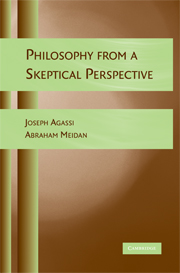Preface
Published online by Cambridge University Press: 05 June 2012
Summary
For more than two centuries, the mainstream rationalist tradition in philosophy took it for granted that its chief role was to respond to the skeptic challenge. It is not quite clear why, for the challenge rests on the assumption that there is nothing to skepticism, that it is not serious, that it is obviously answerable. If so, why bother with it? Moreover, if it is so obviously faulty, why is it so hard to answer? Why do so many philosophers see it as so terrible and threatening to our sanity?
Skepticism is dangerous, most philosophers explain, because it is paralyzing. It is easy to show that this observation is obviously false; skeptics suffer from paralysis no more than other people. Remarkably, critics of skepticism use this observation as an even stronger argument against skepticism. People who claim that they are skeptics are not paralyzed; hence, it follows logically that they only pretend to be skeptics. Yet their preaching, the critics of skepticism continue, however flippant it is, can nonetheless cause harm by spreading discouragement. It is obvious they conclude their argument, that doubt discourages.
All this is very convincing; we do not know why. For, obviously, it is far from the truth: skeptics are not paralyzed because skepticism does not always paralyze. In truth, every philosophy moves some people to action and others to inaction.
- Type
- Chapter
- Information
- Philosophy from a Skeptical Perspective , pp. vii - xivPublisher: Cambridge University PressPrint publication year: 2008



